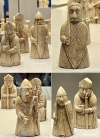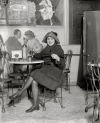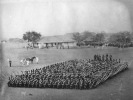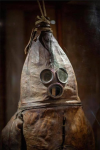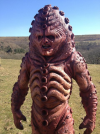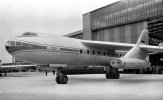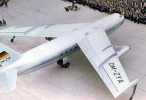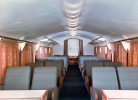Can I have it back please...been looking for that, I left it with some cheese...
You are using an out of date browser. It may not display this or other websites correctly.
You should upgrade or use an alternative browser.
You should upgrade or use an alternative browser.
Cool History Stuff
- Thread starter Rico
- Start date
It doesn't look all that drinkable.
More like edible.
More like edible.
I like the eyes on the pawn (?) in the lower right.
It seems hiw eyes are looking left and his head cocked like "Oh shyte, what's going on over there?" kind of look.
It seems hiw eyes are looking left and his head cocked like "Oh shyte, what's going on over there?" kind of look.
Roman Castellum of Qasr Bashir

Qasr Bashir is an extremely well preserved Roman fortress that lies in the Jordanian desert. Unlike many Roman remains, Qasr Bashir is exceptionally well preserved, having never been re-built by later civilizations.
Qasr Bshir belongs to the chain of forts and watchtowers that is known as the Limes Arabicus and was meant to protect the province of Arabia against roaming desert nomads. They were not extremely dangerous or exceptionally violent, but their dromedaries made them swift, and if trouble arose, they could pillage large parts of the Roman countryside. The Limes Arabicus had to counter this threat, and Mobene was one of the fortifications.
Built at the beginning of the fourth Century AD and known as Mobene, the walls of Qasr Bashir still stand intact, at a height of up to 20 feet in places, while the main entrance remains to this day. The huge corner towers still rise up two stories from the ground.
It is likely that Qasr Bashir was originally home to an auxiliary cavalry unit, charged with defending the Roman frontier and keeping the peace in the surrounding area.
The courtyard, which has two cisterns, is on all sides surrounded by rooms, twenty-three in number, which have been identified as stables. There was a second story, where the soldiers must have slept. The roof of these barracks reached the same height as the rampart walk, creating a really wide fighting platform. One room, opposite the main gate, may have been the headquarters, some kind of sanctuary, or both.
Because each of the twenty-three stables was used by three horses, and because a cavalry unit of frontier soldiers appears to have numbered between 120 and 150 men.
- Images: @APAAME. Reconstruction from Campbell DB, Roman Auxiliary forts 27 BC - AD 378. Fortress Series 83. Osprey Military Publishing, 2009. P. 58.

Qasr Bashir is an extremely well preserved Roman fortress that lies in the Jordanian desert. Unlike many Roman remains, Qasr Bashir is exceptionally well preserved, having never been re-built by later civilizations.
Qasr Bshir belongs to the chain of forts and watchtowers that is known as the Limes Arabicus and was meant to protect the province of Arabia against roaming desert nomads. They were not extremely dangerous or exceptionally violent, but their dromedaries made them swift, and if trouble arose, they could pillage large parts of the Roman countryside. The Limes Arabicus had to counter this threat, and Mobene was one of the fortifications.
Built at the beginning of the fourth Century AD and known as Mobene, the walls of Qasr Bashir still stand intact, at a height of up to 20 feet in places, while the main entrance remains to this day. The huge corner towers still rise up two stories from the ground.
It is likely that Qasr Bashir was originally home to an auxiliary cavalry unit, charged with defending the Roman frontier and keeping the peace in the surrounding area.
The courtyard, which has two cisterns, is on all sides surrounded by rooms, twenty-three in number, which have been identified as stables. There was a second story, where the soldiers must have slept. The roof of these barracks reached the same height as the rampart walk, creating a really wide fighting platform. One room, opposite the main gate, may have been the headquarters, some kind of sanctuary, or both.
Because each of the twenty-three stables was used by three horses, and because a cavalry unit of frontier soldiers appears to have numbered between 120 and 150 men.
- Images: @APAAME. Reconstruction from Campbell DB, Roman Auxiliary forts 27 BC - AD 378. Fortress Series 83. Osprey Military Publishing, 2009. P. 58.
Hoo-hoo, check out those gams. Very risque!
Look further in to it I found out the Canadian Firebirds in 1963 flew the British Electric Lightning F Mk1.
Finding few pictures of the Mk1 I was intrigued by the over/under engines and looked in to the jet further.
Interesting facts.
“The English Electric Lightning was an impressive engineering feat for the British people. She was the first (and only) Mach 2-capable platform ever developed for the island nation and itself the fastest British fighter of all time, the last aircraft to be designed solely by a British aviation firm, the first aircraft to be designed with direct pilot input, the first aircraft to utilize "supercruise" (reaching supersonic flight without the use of afterburner) and the first Royal Air Force platform to feature an integrated weapons system for automated missile delivery. At the time of her inception, the Lightning formed a potent deterrent to Soviet bomber incursions in the region and gave the RAF a potent intercepting arm. One of the most high-performance fighters of the Cold War, the English Electric Lightning went on to find a special place in the hearts of those who flew her and in the admirers of the type all over the world.â€

Finding few pictures of the Mk1 I was intrigued by the over/under engines and looked in to the jet further.
Interesting facts.
“The English Electric Lightning was an impressive engineering feat for the British people. She was the first (and only) Mach 2-capable platform ever developed for the island nation and itself the fastest British fighter of all time, the last aircraft to be designed solely by a British aviation firm, the first aircraft to be designed with direct pilot input, the first aircraft to utilize "supercruise" (reaching supersonic flight without the use of afterburner) and the first Royal Air Force platform to feature an integrated weapons system for automated missile delivery. At the time of her inception, the Lightning formed a potent deterrent to Soviet bomber incursions in the region and gave the RAF a potent intercepting arm. One of the most high-performance fighters of the Cold War, the English Electric Lightning went on to find a special place in the hearts of those who flew her and in the admirers of the type all over the world.â€
English Electric / BAC Lightning
Page details technical specifications, development, and operational history of the English Electric / BAC Lightning including pictures.
www.militaryfactory.com

I can certainly understand why this wasn't a good formation against line infantry!
Only good vs cavalry... or charging dervishes.I can certainly understand why this wasn't a good formation against line infantry!
That was quite the walk about to get there.
Wasn't quite what I was expecting.
I liked seeing things in and around Dublin.
Nice houses and gardens.
Wasn't quite what I was expecting.
I liked seeing things in and around Dublin.
Nice houses and gardens.
At first glance it made me think of the salt sucker from Star Trek. 


Wow!
Doesn't look too much like a converted bomber  so I researched it a bit....
so I researched it a bit....
"The Baade 152 represents the final development in the Junkers aircraft family which ended with the "development planes" (Entwicklungsflugzeug – EF).
Its development drew upon the OKB-1 150, an aborted bomber that was developed in the Soviet Union with assistance from captured German scientists.
The Baade 152's basic configuration shares many similarities, including shape, size, wing-area, landing gear configuration, empty weight, range, altitude, speed, power per engine, and double-engine cowling arrangement with the American-built Boeing B-47 Stratojet, a bomber/aerial reconnaissance aircraft which entered service with the United States Air Force during 1951.
Work on the Baade 152 formally commenced during 1955."
- Wikipedia

 en.wikipedia.org
en.wikipedia.org
"The Baade 152 represents the final development in the Junkers aircraft family which ended with the "development planes" (Entwicklungsflugzeug – EF).
Its development drew upon the OKB-1 150, an aborted bomber that was developed in the Soviet Union with assistance from captured German scientists.
The Baade 152's basic configuration shares many similarities, including shape, size, wing-area, landing gear configuration, empty weight, range, altitude, speed, power per engine, and double-engine cowling arrangement with the American-built Boeing B-47 Stratojet, a bomber/aerial reconnaissance aircraft which entered service with the United States Air Force during 1951.
Work on the Baade 152 formally commenced during 1955."
- Wikipedia







































































































